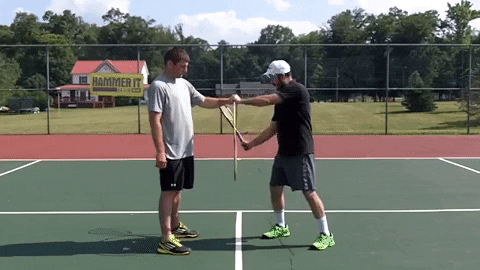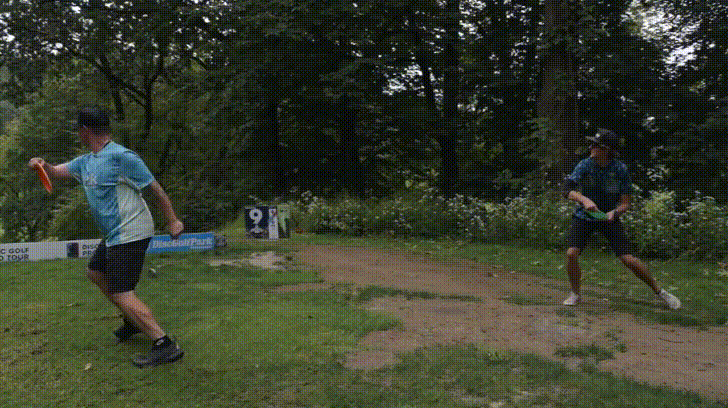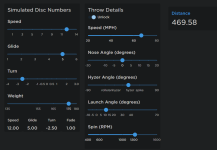disc-golf-neil
Birdie Member
- Joined
- Oct 10, 2023
- Messages
- 475
I'm curious to hear, for those of you who change your grip when you want to throw nose up, how exactly to you grip it to throw really nose up?
Discover new ways to elevate your game with the updated DGCourseReview app!
It's entirely free and enhanced with features shaped by user feedback to ensure your best experience on the course. (App Store or Google Play)
I'd have the same general question. FWIW I found the "don't see the top of the flight plate/flat profile" is still a handy tool to have.I do not have a techdisc, therefore have no data on my own swing, so this is a more general question not an argument.
I have been seeing a lot of talk about negative nose angles, and the ideal being something between -4 and -6 degrees (the numbers vary, but this seems common).
What is this based on exactly? Is there evidence that truly going negative is ideal? I can see clearly when discs fly nose-up, is there footage of discs flying with negative nose angle?
Genuinely just curious about this as I have no idea myself what my nose angle is. My analysis of whether I threw with an effective nose angle is basically just that my view of the disc is a flat profile, I do not ever 'see' the bottom side of the plate in the same way as I see the top side of the plate when I do throw nose-up.
Ya, lol basically same as my thoughts.I'd have the same general question. FWIW I found the "don't see the top of the flight plate/flat profile" is still a handy tool to have.
I have read some basic heuristics people talk about and data on what was working better in my own form for distance lines was what some people around here were saying about GG's mechanics (slight nose down/negative and high line of attack) which in my headcanon I could make sense out of since my form is becoming very centrifugal like his.* I also found that there was such a thing as too nose down and too much late supination (that again was basically just what was outside my natural range of motion and would give me elbow inflammation), which was also when my whole move started to feel jammed up and crappy somewhere. TechDisc data suggested the same but I'm not one of these mega bombers. So interestingly what I thought was "flat profile" was like 3-5 degrees negative and that's when I was getting my max distance at lowest effort.
In general or in very advanced/70mph+ forms I'd like to know.
*I forget where it is, but Sidewinder posted a couple hypothetical TechDisc simulations to that effect IIRC, and I'm curious about live throws.
Yes, terms/phrases are all getting intermingled with completely different meanings.I thought "turning the key" was for anhyzers, and don,t you do it in the back swing?
The way I am understanding this other technique( flipping ) just before release seems like a bad habit that will hurt you pretty quickly.
To change the nose angle I simply adjust my grip.
Like ball golf , I think most issues players have are due to poor grip.
I'll be curious if you find it to be at least more than useless - I guess what it confirmed in my own personal development was that I was doing the "right" thing by following the "natural motion pattern" philosophy. Getting long, loose, leveraged, and quick at the end of the move was always breaking when certain things were going wrong either in the grip or upstream. I think that got easier again once I stopped throwing as much and did a lot of "athletic" exercises over the winter to make up for lost time that made me do those things for other tasks. I didn't really understand the point (physically) of 2-finger grips until after that because then I was like "oh, that's what the "tip of the whip' is", more or less.Ya, lol basically same as my thoughts.
I should have a techdisc within a month so maybe I will find that I do in fact have a negative angle when it looks neutral, I truly have no idea.
It does seem like some people are trying to chase lower and lower nose angles as if it is the goal, and I will be very, very surprised if anything actually proves that you want anything like 9-10 degrees negative. I absolutely do not think the techdisc flight model should be used as evidence that this is an effective goal, and I can't conceive of an easy way to answer this.
Some engineer needs to make a disc throwing arm that can manipulate all of this but have truly consistent form man, we'd learn so much.
Yes, terms/phrases are all getting intermingled with completely different meanings.
If you mean the tech disc flight model stuff, I highly doubt I will ever give a single care about it lol.I'll be curious if you find it to be at least more than useless
Yeah, more just about anything you like/dislike about it after you mess around with it.If you mean the tech disc flight model stuff, I highly doubt I will ever give a single care about it lol.
I want this almost 100% for nose angle experimentation.
I don't know where the -4 to -6 came from, perhaps it was some aerodynamic computer simulation.I do not have a techdisc, therefore have no data on my own swing, so this is a more general question not an argument.
I have been seeing a lot of talk about negative nose angles, and the ideal being something between -4 and -6 degrees (the numbers vary, but this seems common).
What is this based on exactly? Is there evidence that truly going negative is ideal? I can see clearly when discs fly nose-up, is there footage of discs flying with negative nose angle?
Genuinely just curious about this as I have no idea myself what my nose angle is. My analysis of whether I threw with an effective nose angle is basically just that my view of the disc is a flat profile, I do not ever 'see' the bottom side of the plate in the same way as I see the top side of the plate when I do throw nose-up.
Ya, my unscientific theory is that it doesn't really matter as long as it is at least extremely close to neutral nose angle. I think you might be right, and that negative nose angle is just a hedge against the incredibly unwanted positive nose angle, but that flight characteristics between 0.00 and -5 probably don't change all that much.I don't know where the -4 to -6 came from, perhaps it was some aerodynamic computer simulation.
I think I recall seeing a video (Not sure which) that used a computer sim (not tech disc) or referenced an academic paper but it showed that the initial nose down is largely lost as the disc flies so I think more knows down, gives you more of a buffer on the nose the nose down being lost in flight to avoid stalling.
There's also the attached, Chris Taylor picture which shows GG having the lowest nose angle by far, that, in addition to his elite spin seems to be why at a lower arm speed he's able to stay competitive for longer and distance competitions which lends some credibility to the value of extra nose down.
Anyone can go onto the TechDisc website and use their simulator and change the nose angle and see what happens. even at a 10° launch angle at some point, making the nose lower than -4 will reduce distance if I recall, but at more extreme positive launch angles when going after a long high pushing glide phase I think that's where some extra nose down might be useful but I haven't checked the tech disc sim on that.
Nice, glad you shared this here, thanks.I don't know where the -4 to -6 came from, perhaps it was some aerodynamic computer simulation.
I think I recall seeing a video (Not sure which) that used a computer sim (not tech disc) or referenced an academic paper but it showed that the initial nose down is largely lost as the disc flies so I think more knows down, gives you more of a buffer on the nose the nose down being lost in flight to avoid stalling.
There's also the attached, Chris Taylor picture which shows GG having the lowest nose angle by far, that, in addition to his elite spin seems to be why at a lower arm speed he's able to stay competitive for longer and distance competitions which lends some credibility to the value of extra nose down.
Anyone can go onto the TechDisc website and use their simulator and change the nose angle and see what happens. even at a 10° launch angle at some point, making the nose lower than -4 will reduce distance if I recall, but at more extreme positive launch angles when going after a long high pushing glide phase I think that's where some extra nose down might be useful but I haven't checked the tech disc sim on that.
Also, doesn't GG's form, have one of the most clearly visible dynamic wrist supination movements? And this Chris Taylor data (assuming low sample size) suggests he has the better nose down control.


I was going to post it in the vid tomorrow but I'll share now since you also tested.Regarding nose up:
I've basically found the opposite of what @disc-golf-neil showed for nose down experiments works for creating nose up angles.
Three ways I've seen to manipulate it:
1. Swoop (aka air bounce)
2. Pronate the arm into the hit. It may also be helpful to move the thumb deeper into the flight plate for pronounced effect.
3. Radial deviation (opposite of pour the coffee)



I think you've got to mess with a super flippy disc on that high of a launch. Distance lines are typically throwing very high with something that'll turn like crazy to carry the nose down and make use of gravity on the tail end.Something else that's interesting is keeping the speed and spin the same but adjusting the other stats in the tech disc flight sim to get the furthest distance, I can't actually find a combo of stats with nose down that goes clearly further than nose neutral. Who knows how accurate this is:
View attachment 336019
View attachment 336020
I emailed tech disc asking them if they are just making things up with nose angle now. Maybe I messed a stat up though.